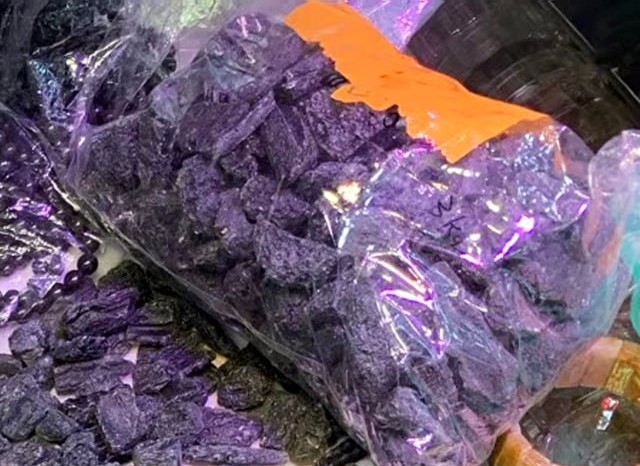Learning how to take care of your Moldavite
This article is about abrasion damage to help you learn how to take care of your Moldavite.
What is abrasion damage?
Abrasion is one form of damage to Moldavite where the surface is scraped or worn away. Abrasion damaged can be natural in the environment over time or artificial due to poor packing and transportation.
Hardness of Moldavite compared to other crystals and minerals
A Mohs scale of hardness is a rating given for an item’s resistance to scratching or abrasion. It ranges from 1 which is very low resistance to scratching to 10 which is very high resistance to scratching. The Mohs scale is useful to understand how easily Moldavite will get damaged.
Moldavite has a Mohs scale rating of between 6.5 to 6.9 for most Moldavite (not 5.5 to 7 as some sources suggest as this range is too large). This rating of 6.5 to 6.9 is from a researcher who wrote the book “Moldavites The Czech Tektites (1994)”.
Items of a similar or higher Mohs rating to Moldavite would more easily scratch or cause abrasion damage. For example, Moldavite kept in a carry pouch with other Moldavite and Quartz crystals would cause abrasion damage and scratching to the Moldavite.
One reason why Moldavite is often nicked and chipped when mining is due to its Mohs scale and the surrounding sediments. Feldspare (Mohs 6) and Quartz (Mohs 7) are often in the surrounding sediments around Moldavite and can scratch the Moldavite when sorting through them to find Moldavite.
Below is a table with some examples of minerals and objects at each level of the Mohs scale:
- Mohs scale 10 – Diamond
- Mohs scale 9 – Ruby, Sapphire
- Mohs scale 8 – Topaz, Cubic Zirconia
- Mohs scale 7 – Quartz (Clear Quartz, Smokey Quartz, etc), Tourmaline
- Mohs scale 6 – Moldavite (natural glass), Feldspar
- Mohs scale 5 – Man made glass, tooth enamel
- Mohs scale 4 – Fluorite
- Mohs scale 3 – Pearl
- Mohs scale 2 – Amber
- Mohs scale 1 – Talc
Natural abrasion
Natural abrasion is caused through the natural transportation of the Moldavite over millions of years due to movement caused by gravity (e.g. Moldavite rolling down a slope) or water (e.g. pushing the Moldavite against other stones and transporting them). The sediments surrounding the Moldavite is generally gravel, sand and rocks which includes quartz, quartzite, feldspar, granite and gneiss. Some of these sediments have a higher hardness of the Mohs scale meaning that that would damage Moldavite if rubbed against.
Artificial abrasion
Poor handling, storage, packing and transport of Moldavite can cause abrasion damage to Moldavite. For example, if Moldavite is not packed and transported properly, every movement during transport would cause each of the Moldavite pieces to rub against each other. Over time, this causes damage to the Moldavite’s surface and it will become worn out due to the rubbing.
Unfortunately, abrasion damage happens due to a lack of education on storing or transporting Moldavite, corner cutting to save costs with packing and transport, or a lack of respect for Moldavite (e.g. not caring if they get damaged). Moldavite should always be wrapped individually in plastic or tissue when being transported.
Picture: Example of Moldavite packed loosely in a bag for transporting causing significant abrasion damage

What does abrasion damage look like?
The surface of Moldavite is usually sculpted with fine lines, grooves, channels, pits and sometimes sharp edges. Abrasion damaged the surface of Moldavite to be more blunt, worn out rounded and matte. The surface of the Moldavite is literally scratched off and the overall size of the Moldavite will decrease as it gets destroyed. There are some example pictures below.
Different stages of abrasion
Early stages of abrasion damage would look like some of the natural surface shine/gloss has been rubbed off and there are some matte looking parts. There may be an inconsistent surface appearance with some parts which look more matte and some parts which look more glossy. The Moldavite may start to lose some of its edges and look more rounded.
Intermediate to advanced stages of abrasion damage would look like an overall rounding of the shape and a scratched or worn out look on the surface. There would be no pointy edges remaining and the shape starts to become oval. The surface becomes nontransparent due to the matte surface. If the cause of the abrasion damage is allowed to continue, the Moldavite would eventually be completed destroyed.
Simulated abrasion damage of Moldavite
The damage of abrasion on Moldavite was simulated in a lab to show the progressive damage to Moldavite. Moldavite was rotated in a barrel with sediments similar to what is usually surrounding Moldavite in the ground which is gravel, sand and rocks which includes quartz, quartzite, feldspar, granite and gneiss. You can see how the surface gloss changes as the surface is eroded, the edges are destroyed and the shape is worn down to an oval.
Picture: Example 1 of abrasion damage

Picture: Example 2 of abrasion damage

Preventing abrasion damage
Preventing abrasion damage is easy with the right care and handling. When transporting Moldavite, you should wrap each Moldavite individually either in tissue or in a plastic zip lock bag to prevent rubbing. Additionally, if you carry Moldavite it should be in a pouch by itself and not where it rubs against other harder crystals or rocks.
When storing Moldavite, arrange your Moldavite so there is a small gap between it and any other Moldavite, crystals or rocks to prevent accidental rubbing.
Want more useful information?
See the guides:
Guide to Genuine and Fake Moldavite: www.stonesoftransformation.com.au/blog/fake-moldavite-guide/
The Best Guide on Spotting and Avoiding Fake Moldavite: www.stonesoftransformation.com.au/the-best-guide-on-spotting-and-avoiding-fake-moldavite/
Shapes of Moldavite: www.stonesoftransformation.com.au/blog/guide-to-the-shapes-of-moldavite/
Busting myths of Moldavite: www.stonesoftransformation.com.au/busting-some-myths-of-moldavite/
Other useful guides and blog posts: www.stonesoftransformation.com.au/blog/list-of-useful-posts/
Follow our Facebook page for updates on great information: www.facebook.com/StonesofTransformationMoldaviteStore
Customer reviews: www.stonesoftransformation.com.au/reviews/
Shop and sale page: www.stonesoftransformation.com.au/shop/
